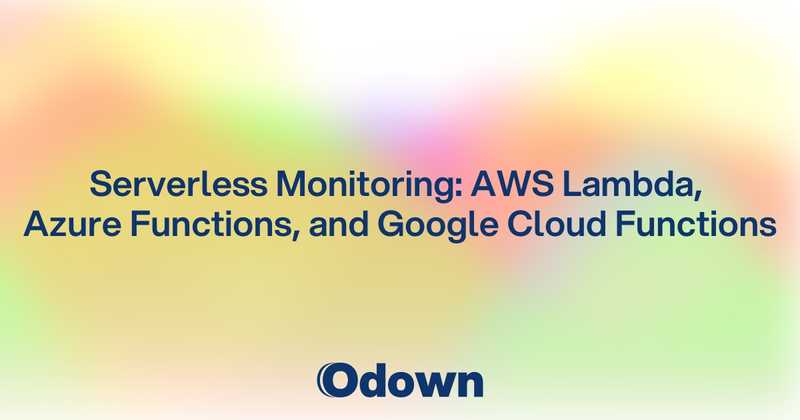Serverless Monitoring: AWS Lambda, Azure Functions, and Google Cloud Functions
Your serverless function just took 30 seconds to process a request that should complete in 200 milliseconds. Your users are frustrated, your costs are skyrocketing, and you have no idea what's happening inside that black box. Welcome to serverless monitoring hell.
Serverless functions promise to eliminate infrastructure management, but they create entirely new monitoring challenges. Traditional monitoring approaches don't work when your code runs for seconds at a time in ephemeral containers that disappear after each execution.
The serverless monitoring paradox is real: you have less infrastructure to manage but more complexity to monitor. Cold starts, timeout errors, memory limits, and execution costs all require specialized monitoring approaches that traditional tools weren't designed to handle.
Modern monitoring platforms adapt to serverless architectures by providing function-specific insights that help you optimize performance, control costs, and maintain reliability. But understanding serverless monitoring requires rethinking everything you know about application observability.
Serverless Monitoring Challenges: Cold Starts, Timeouts, and Resource Limits
Serverless functions operate under constraints that don't exist in traditional server environments. These constraints create monitoring challenges that can trip up even experienced developers.
Cold Start Performance Impact
Cold starts are the biggest performance wildcard in serverless environments, and they're notoriously difficult to predict and monitor:
Cold start frequency varies based on factors you can't directly control. Your function might start cold after periods of inactivity, but the exact timing depends on the cloud provider's internal resource management algorithms.
Cold start duration depends on runtime, package size, and initialization code complexity. A Python function might cold start faster than a Java function, but large dependency packages can slow down any runtime significantly.
Provisioned concurrency and other warming strategies help reduce cold starts but add complexity and cost to your monitoring strategy. You need to track whether your warming strategies are actually effective and worth their additional expense.
Timeout and Resource Limit Monitoring
Serverless functions operate within strict resource constraints that can cause unexpected failures:
Memory limit monitoring reveals when functions are hitting RAM constraints that cause crashes or performance degradation. Unlike traditional servers, serverless functions can't use swap space when they run out of memory.
Execution time monitoring tracks how close your functions come to timeout limits. A function that consistently runs close to its timeout limit might need optimization or a longer timeout configuration.
Concurrent execution limits can cause throttling that affects user experience. AWS Lambda has account-level concurrency limits that can cause function invocations to fail during traffic spikes.
Debugging Ephemeral Environments
Traditional debugging techniques don't work when your execution environment disappears after each function invocation:
Log correlation becomes crucial when function instances don't persist between invocations. You need to track request IDs and correlation tokens across multiple function executions to understand user journeys.
State management monitoring tracks how your functions handle stateless execution requirements. Functions that assume persistent state often fail in unpredictable ways that are difficult to reproduce.
Error reproduction challenges arise because serverless environments are inherently non-deterministic. The same function invocation might behave differently based on which container instance handles the request.
Function Performance Optimization: Memory, CPU, and Execution Time Monitoring
Optimizing serverless function performance requires understanding the unique characteristics of each cloud provider's execution environment and how your code interacts with those constraints.
Memory Allocation and Usage Analysis
Memory configuration directly affects both performance and cost in serverless environments:
Memory utilization tracking shows whether your functions are over-provisioned or under-provisioned for memory. Over-provisioning wastes money, while under-provisioning causes performance problems or crashes.
Memory allocation impact on CPU performance matters because many serverless platforms allocate CPU power proportionally to memory allocation. Your function might be slow due to insufficient CPU rather than actual memory constraints.
Garbage collection monitoring is particularly important for managed runtime languages like Java and C#. Garbage collection pauses can consume significant portions of your execution time budget.
CPU Performance Characteristics
CPU performance in serverless environments behaves differently than traditional server environments:
Shared infrastructure effects mean your function's CPU performance might vary based on other workloads running on the same physical hardware. This variability makes consistent performance monitoring more important.
Burst performance capabilities allow some serverless platforms to provide higher CPU performance for short periods. Understanding these characteristics helps you optimize function execution patterns.
CPU throttling occurs when functions exceed their allocated CPU budget over time. This is particularly relevant for functions that run for extended periods or process CPU-intensive workloads.
Execution Time Optimization
Every millisecond of execution time costs money and affects user experience in serverless environments:
Initialization time optimization focuses on reducing the time your function spends setting up dependencies and establishing connections. This is particularly important for reducing cold start impact.
Business logic execution time should be monitored separately from initialization overhead to understand where optimization efforts will have the most impact.
External dependency timing tracks how much of your execution time is spent waiting for databases, APIs, or other external services. Slow external dependencies can make your function appear inefficient when the problem lies elsewhere.
Serverless Cost Monitoring: Usage Tracking and Budget Optimization
Serverless cost optimization requires detailed understanding of how your usage patterns translate into billing charges across different pricing models and cloud providers.
Usage Pattern Analysis
Serverless costs depend on complex interactions between invocation frequency, execution duration, and resource allocation:
Invocation frequency monitoring tracks how often your functions are called and helps identify cost optimization opportunities. Functions with predictable traffic patterns might benefit from provisioned concurrency or scheduled scaling.
Execution duration distribution analysis reveals whether your functions have consistent performance or highly variable execution times. Variable execution times make cost forecasting difficult and might indicate optimization opportunities.
Resource allocation efficiency measures whether your current memory and timeout settings provide good value for your specific workloads. Small adjustments to resource allocation can significantly impact costs without affecting performance.
Cost Attribution and Chargeback
Understanding which business activities drive serverless costs helps optimize spending and allocate expenses appropriately:
Function-level cost tracking breaks down expenses by individual functions to identify the most expensive components of your serverless architecture. This information helps prioritize optimization efforts.
Feature-based cost allocation maps serverless expenses to business features or customer activities. This mapping helps product teams understand the true cost of feature development and maintenance.
Environment-specific cost analysis compares spending across development, staging, and production environments to identify potential waste or unexpected usage patterns.
Budget Management and Forecasting
Serverless costs can scale quickly with usage, making budget management and forecasting particularly important:
Spending trend analysis helps predict future costs based on current usage patterns and business growth projections. Sudden changes in spending trends might indicate problems or opportunities.
Cost anomaly detection identifies unusual spending patterns that might indicate bugs, attacks, or misconfigured functions. A function that suddenly starts executing thousands of times per minute probably has a problem.
Budget alerting systems should account for the variable nature of serverless costs and provide early warning when spending approaches predefined limits.
Serverless Security Monitoring: IAM, VPC, and Runtime Protection
Serverless functions introduce unique security challenges that require specialized monitoring approaches to detect and prevent security issues.
Identity and Access Management Monitoring
Serverless functions often require extensive IAM permissions that can create security vulnerabilities if not properly monitored:
Permission usage tracking monitors which IAM permissions your functions actually use versus which permissions they have been granted. Over-privileged functions create unnecessary security risks.
Cross-service access monitoring tracks how your functions interact with other cloud services and whether those interactions follow security best practices. Functions that access sensitive services should be monitored more closely.
Role assumption patterns help identify unusual access patterns that might indicate compromised functions or insider threats. Functions that suddenly start accessing different resources might be behaving maliciously.
Network Security and VPC Monitoring
Functions that run inside VPCs have additional security considerations that require monitoring:
VPC configuration monitoring ensures that your functions have appropriate network isolation and can only access intended resources. Misconfigured VPC settings can expose functions to network-based attacks.
Network traffic analysis tracks inbound and outbound connections from your functions to identify suspicious communication patterns. Functions that start communicating with unexpected endpoints might be compromised.
Security group compliance monitoring verifies that your functions' network access controls remain consistent with security policies over time.
Runtime Security and Vulnerability Monitoring
The serverless runtime environment itself needs monitoring for security issues:
Dependency vulnerability scanning tracks known security vulnerabilities in the packages and libraries your functions use. Serverless functions often include many dependencies that can introduce security risks.
Runtime behavior monitoring detects unusual function behavior that might indicate security compromises. Functions that suddenly start consuming more resources or accessing different services might be running malicious code.
Code injection detection monitors for signs that your functions are executing unexpected code or commands. This is particularly important for functions that process user input or external data.
Effective serverless monitoring requires understanding the unique characteristics of function-based architectures. Multi-cloud monitoring strategies provide the foundation for monitoring serverless functions across different cloud platforms.
Ready to implement comprehensive serverless function monitoring? Use Odown and gain the specialized monitoring capabilities your serverless architecture needs for optimal performance, cost control, and security.



